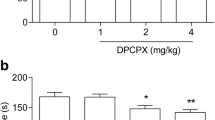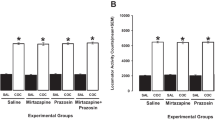Abstract
Rationale
Pre-clinical and clinical studies have suggested that the antidepressant efficacy of escitalopram (ESC) can be augmented by co-administration of aripiprazole (ARI).
Objective
To establish if the effects of ESC + ARI can be altered by modulating the 5-HT1a receptor.
Methods
Sprague-Dawley male rats received ESC + ARI (10 and 2 mg/kg/day, respectively, via osmotic or by cumulative injections), as well as the 5-HT1a antagonist WAY-100635 (WAY; 0.01–1 mg/kg) and the 5-HT1a agonist 8-OH-DPAT (DPAT; 0.3–1 mg/kg) prior to testing in locomotion chambers and in the forced swim test (FST). Expression of the 5-HT1a receptor mRNA in the dorsal raphe nucleus, hippocampus, septum, and entorhinal cortex was also assessed.
Results
WAY generally synergized, while DPAT antagonized, the effect of ESC + ARI on motor activity. All groups showed significantly lower 5-HT1a mRNA in the dorsal raphe nucleus. In the hippocampus, ESC + ARI and WAY + ESC + ARI groups displayed equivalent elevations of 5-HT1a mRNA, but this was not observed in groups that received DPAT + ESC + ARI. Finally, the addition of ARI to ESC augmented the effect that ESC alone had on reducing immobility in the FST. Importantly, WAY antagonized this effect, while DPAT had no consequences.
Conclusions
Taken together, these results in rats indicate that the 5-HT1a receptor is involved in the behavioral and brain region-specific mRNA effects of ESC + ARI.




Similar content being viewed by others
Change history
22 May 2019
After publication of this paper, the authors determined an error in Fig. 3. Below is the correct Fig. 3.
References
Abbas SY, Nogueira MI, Azmitia EC (2006) Antagonist-induced increase in 5-HT1a-receptor expression in adult rat hippocampus and cortex. Synapse 495:485–495. https://doi.org/10.1002/syn
Adell A, Artigas F (1998) A microdialysis study of the in vivo release of 5-HT in the median raphe nucleus of the rat. Br J Pharmacol 125:1361–1367. https://doi.org/10.1038/sj.bjp.0702206
Albert PR (2012) Transcriptional regulation of the 5-HT1a receptor: implications for mental illness. Philos Trans R Soc B Biol Sci 367:2402–2415. https://doi.org/10.1098/rstb.2011.0376
Albert PR, Le François B (2010) Modifying 5-HT1a receptor gene expression as a new target for antidepressant therapy. Front Neurosci 4:1–7. https://doi.org/10.3389/fnins.2010.00035
Berman RM, Darnell AM, Miller HL et al (1997) Effect of pindolol in hastening response to fluoxetine in the treatment of major depression. Am J Psychiatry 154:37–43
Berman RM, Marcus RN, Swanink R et al (2007) The efficacy and safety of aripiprazole as adjunctive therapy in major depressive disorder: a multicenter, randomized, double-blind, placebo-controlled study. J Clin Psychiatry 68:843–853. https://doi.org/10.1093/acprof:oso/9780199641819.001.0001
Berman RM, Fava M, Thase ME, Trivedi MH, Swanink R, McQuade RD, Carson WH, Adson D, Taylor L, Hazel J, Marcus RN (2009) Aripiprazole augmentation in major depressive disorder: a double-blind, placebo-controlled study in patients with inadequate response to antidepressants. CNS Spectr 14:197–206. https://doi.org/10.1017/S1092852900020216
Blier P (2017) Effect of combining aripiprazole with escitalopram on serotonergic and noradrenergic neurotransmission in the rat hippocampus. Biol Psychiatry 81:S267
Blier P, Blondeau C (2011) Neurobiological bases and clinical aspects of the use of aripiprazole in treatment-resistant major depressive disorder. J Affect Disord 128:S3–S10. https://doi.org/10.1016/S0165-0327(11)70003-9
Blier P, Ward NM (2003) Is there a role for 5-HT1a agonists in the treatment of depression? Biol Psychiatry 53:193–203. https://doi.org/10.1016/S0006-3223(02)01643-8
Bourin M, Chenu F, Prica C, Hascoët M (2009) Augmentation effect of combination therapy of aripiprazole and antidepressants on forced swimming test in mice. Psychopharmacology 206:97–107. https://doi.org/10.1007/s00213-009-1583-7
Branch AD, Unterwald EM, Lee SE, Kreek MJ (1992) Quantitation of preproenkephalin mRNA levels in brain regions from male fischer rats following chronic cocaine treatment using a recently developed solution hybridization assay. Mol Brain Res 14:231–238. https://doi.org/10.1016/0169-328X(92)90178-E
Carey RJ (2010) Serotonin and Basal Sensory–Motor Control In Muller, C & Jacobs, B (Ed.) Handbook of the Behavioral Neurobiology of Serotonin (pp 325-330). London, Elsevier Academic Press
Carey RJ, Depalma G, Damianopoulos E et al (2004a) Dopaminergic and serotonergic autoreceptor stimulation effects are equivalent and additive in the suppression of spontaneous and cocaine induced locomotor activity. Brain Res 1019:134–143. https://doi.org/10.1016/j.brainres.2004.05.091
Carey RJ, DePalma G, Damianopoulos E, Müller CP, Huston JP (2004b) The 5-HT1a receptor and behavioral stimulation in the rat: effects of 8-OHDPAT on spontaneous and cocaine-induced behavior. Psychopharmacology 177:46–54. https://doi.org/10.1007/s00213-004-1917-4
Chernoloz O, El Mansari M, Blier P (2009) Electrophysiological studies in the rat brain on the basis for aripiprazole augmentation of antidepressants in major depressive disorder. Psychopharmacology 206:335–344. https://doi.org/10.1007/s00213-009-1611-7
Cryan JF, Valentino RJ, Lucki I (2005) Assessing substrates underlying the behavioral effects of antidepressants using the modified rat forced swimming test. Neurosci Biobehav Rev 29:547–569. https://doi.org/10.1016/j.neubiorev.2005.03.008
De Bartolomeis A, Tomasetti C, Iasevoli F (2015) Update on the mechanism of action of aripiprazole: translational insights into antipsychotic strategies beyond dopamine receptor antagonism. CNS Drugs 29:773–799. https://doi.org/10.1007/s40263-015-0278-3
Detke MJ, Rickels M, Lucki I (1995) Active behaviors in the rat forced swimming test differentially produced by serotonergic and noradrenergic antidepressants. Psychopharmacology 121:66–72. https://doi.org/10.1007/BF02245592
El Mansari M, Sánchez C, Chouvet G et al (2005) Effects of acute and long-term administration of escitalopram and citalopram on serotonin neurotransmission: an in vivo electrophysiological study in rat brain. Neuropsychopharmacology 30:1269–1277. https://doi.org/10.1038/sj.npp.1300686
Fabre V, Beaufour C, Evrard A, Rioux A, Hanoun N, Lesch KP, Murphy DL, Lanfumey L, Hamon M, Martres MP (2000) Altered expression and functions of serotonin 5-HT(1A) and 5-HT(1B) receptors in knock-out mice lacking the 5-HT transporter. Eur J Neurosci 12:2299–2310. https://doi.org/10.1046/j.1460-9568.2000.00126.x
Fava M, Mischoulon D, Losifescu D et al (2012) A double-blind, placebo-controlled study of aripiprazole adjunctive to antidepressant therapy among depressed outpatients with inadequate response to prior antidepressant therapy (ADAPT-A study). Psychother Psychosom 81:87–97. https://doi.org/10.1159/000332050
Fletcher A, Forster EA, Bill DJ, Brown G, Cliffe IA, Hartley JE, Jones DE, McLenachan A, Stanhope KJ, Critchley DJP, Childs KJ, Middlefell VC, Lanfumey L, Corradetti R, Laporte AM, Gozlan H, Hamon M, Dourish CT (1995) Electrophysiological, biochemical, neurohormonal and behavioural studies with WAY-100635, a potent, selective and silent 5-HT1a receptor antagonist. Behav Brain Res 73:337–353. https://doi.org/10.1016/0166-4328(96)00118-0
Hjorth S, Westlin D, Bengtsson HJ (1997) WAY100635-induced augmentation of the 5-HT-elevating action of citalopram: relative importance of the dose of the 5-HT(1A) autoreceptor blocker versus that of the 5-HT reuptake inhibitor. Neuropharmacology 36:461–465. https://doi.org/10.1016/S0028-3908(97)00050-6
Hjorth S, Bengtsson HJ, Kullberg A, Carlzon D, Peilot H, Auerbach SB (2000) Serotonin autoreceptor function and antidepresent drug actions. J Psychopharmacol 14:177–185
Huang J, Azmitia EC (1999) Homologous regulation of 5-HT1a receptor mRNA in adult rat hippocampal dentate gyrus. Neurosci Lett 270:5–8. https://doi.org/10.1016/S0304-3940(99)00439-5
Hudson R, Zhou Y, Leri F (2017) The combination of escitalopram and aripiprazole: investigation of psychomotor effects in rats. J Psychopharmacol 31:1605–1614. https://doi.org/10.1177/0269881117732515
Invernizzi R, Velasco C, Bramante M et al (1997) Effect of 5-HT1a receptor antagonists on citalopram - induced increase in extracellular serotonin in the frontal cortex, striatum and dorsal hippocampus. Neuropharmacology 36:467–473
Johnson RG, Fiorella D, Winter JC, Rabin RA (1997) [3H]8-OH-DPAT labels a 5-HT site coupled to inhibition of phosphoinositide hydrolysis in the dorsal raphe. Eur J Pharmacol 329:99–106. https://doi.org/10.1016/S0014-2999(97)10113-3
Kaminska K, Rogoz Z (2016) The antidepressant - and anxiolytic-like effects following co-treatment with escitalopram and risperidone in rats. J Physiol Pharmacol 67:471–480
Kelly PH, Seviour PW, Iverson SD (1975) Amphetamine and apomorphine responses in the rat following 6-OHDA lesions of the nucleus accumbens septi and corpus striatum. Brain Res 94:507–522
Le Poul E, Boni C, Hanoun N et al (2000) Differential adaptation of brain 5-HT(1A) and 5-HT(1B) receptors and 5-HT transporter in rats treated chronically with fluoxetine. Neuropharmacology 39:110–122. https://doi.org/10.1016/S0028-3908(99)00088-X
Marcus RN, McQuade RD, Carson WH et al (2008) The efficacy and safety of aripiprazole as adjunctive therapy in major depressive disorder: a second multicenter, randomized, double-blind, placebo-controlled study. J Clin Psychopharmacol 28:156–165. https://doi.org/10.1097/JCP.0b013e31816774f9
Müller CP, Carey RJ, De Souza Silva MA et al (2002) Cocaine increases serotonergic activity in the hippocampus and nucleus accumbens in vivo: 5-HT1a-receptor antagonism blocks behavioral but potentiates serotonergic activation. Synapse 45:67–77. https://doi.org/10.1002/syn.10083
Müller CP, Carey RJ, Huston JP, De Souza Silva MA (2007) Serotonin and psychostimulant addiction: focus on 5-HT1a-receptors. Prog Neurobiol 81:133–178. https://doi.org/10.1016/j.pneurobio.2007.01.001
Nelson JC, Papakostas GI (2009) Atypical antipsychotic augmentation in major depressive disorder: a meta-analysis of placebo-controlled randomized trials. Am J Psychiatry 166:980–991
Nelson JC, Pikalov A, Berman RM (2008) Augmentation treatment in major depressive disorder: focus on aripiprazole. Neuropsychiatr Dis Treat 4:937–948
Nelson JC, Thase ME, Bellocchio EE, Rollin LM, Eudicone JM, McQuade RD, Marcus RN, Berman RM, Baker RA (2012) Efficacy of adjunctive aripiprazole in patients with major depressive disorder who showed minimal response to initial antidepressant therapy. Int Clin Psychopharmacol 27:125–133. https://doi.org/10.1097/YIC.0b013e3283502791
Ozaki N, Otsubo T, Kato M, Higuchi T, Ono H, Kamijima K, ADMIRE Study Group (2015) Efficacy of aripiprazole augmentation in Japanese patients with major depressive disorder: a subgroup analysis and Montgomery–Åsberg Depression Rating Scale and Hamilton Rating Scale for depression item analyses of the aripiprazole depression multicenter efficacy study. Psychiatry Clin Neurosci 69:34–42. https://doi.org/10.1111/pcn.12214
Papakostas GI, Shelton RC, Smith J, Fava M (2007) Augmentation of antidepressants with atypical antipsychotic medications for treatment-resistant major depressive disorder: a meta-analysis. J Clin Psychiatry 68:826–831. https://doi.org/10.4088/JCP.v68n0602
Patkar AA, Peindl K, Mago R, Mannelli P, Masand PS (2006) An open-label, rater-blinded, augmentation study of aripiprazole in treatment-resistant depression. Prim Care Companion J Clin Psychiatry 8:82–87. https://doi.org/10.4088/PCC.v08n0205
Perez V, Soler J, Puidgemont D et al (1999) A double-blind, randomized, placebo-controlled trial of pindolol augmentation in depressive patients resistant to serotonin reuptake inhibitors. Arch Gen Psychiatry 56:375–379
Perry EB, Berman RM, Sanacora G et al (2004) Pindolol augmentation in depressed patients resistant to selective serotonin reuptake inhibitors: a double-blind, randomized, controlled trial. J Clin Psychiatry 65:238–243. https://doi.org/10.4088/JCP.v65n0215
Pompeiano M, Palacios JM, Mengod G (1992) Distribution and cellular localization of mRNA coding for 5-HT1a receptor in the rat brain: correlation with receptor binding. J Neurosci 12:440–453
Slattery DA, Cryan JF (2012) Using the rat forced swim test to assess antidepressant-like activity in rodents. Nat Protoc 7:1009–1014
Stark AD, Jordan S, Allers KA, Bertekap RL, Chen R, Mistry Kannan T, Molski TF, Yocca FD, Sharp T, Kikuchi T, Burris KD (2007) Interaction of the novel antipsychotic aripiprazole with 5-HT1a and 5-HT2a receptors: functional receptor-binding and in vivo electrophysiological studies. Psychopharmacology 190:373–382. https://doi.org/10.1007/s00213-006-0621-y
Funding
This study was part of the Canadian Biomarker Integration Network in Depression (CAN-BIND) program (www.canbind.ca). CAN-BIND is an Integrated Discovery Program carried out in partnership with, and financial support from, the Ontario Brain Institute, an independent non-profit corporation, funded partially by the Ontario government. The opinions, results, and conclusions are those of the authors and no endorsement by the Ontario Brain Institute is intended or should be inferred.
Author information
Authors and Affiliations
Corresponding author
Ethics declarations
All experiments were approved by the Animal Care Committee of the University of Guelph and were carried out in accordance with recommendations provided by the Canadian Council on Animal Care.
Conflict of interest
The authors declare that they have no conflict of interest.
Additional information
Publisher’s note
Springer Nature remains neutral with regard to jurisdictional claims in published maps and institutional affiliations.
Rights and permissions
About this article
Cite this article
Lapointe, T., Hudson, R., Daniels, S. et al. Effects of combined escitalopram and aripiprazole in rats: role of the 5-HT1a receptor. Psychopharmacology 236, 2273–2281 (2019). https://doi.org/10.1007/s00213-019-05225-z
Received:
Accepted:
Published:
Issue Date:
DOI: https://doi.org/10.1007/s00213-019-05225-z




